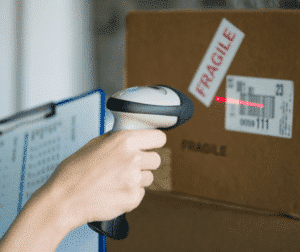Bar code reader (scanner)
Basically, it connects to a PC with a USB cable (RS232C in the old days), but the type that pairs with a PC via Bluetooth is called a Bluetooth scanner or a Wireless scanner.

By the way, a one-to-one connection to a PC with a USB cable is called a cable connection (as it is), but connecting two devices that communicate via Bluetooth is called by a special term "pairing" rather than a Bluetooth connection.
The reason for this is that, for example, when a smartwatch and a smartphone are connected and a Bluetooth scanner is used for shipping, a procedure is used to select the PC's signal from among the three Bluetooth radio waves to communicate with it, and this is more than just a connection. A barcode reader, also known as a scanner, serves two purposes.
Barcode readers, also called scanners, simply scan barcodes and capture data, and it is sufficient if they serve two purposes: saving labor by manually entering data from a keyboard and preventing erroneous input.
For example, in the case of reading the "Instruction No." in the instruction manual, the role is to quickly and accurately enter the Instruction No. into the search field. The information (start time, end time, actual quantity) is entered and updated.
For example, in the case of reading the item code and lot number on a piece count sheet, the barcode reader only displays the inventory information (item, lot number, location, quantity, etc.) and the operator continues to update the actual information (location, actual quantity, etc.) by entering it on the screen.
Within a barcode reader-based operation, the operating entity changes as follows.
- Barcode reader (the entity that reads key information)
- PC-side application (the entity that displays information from DB based on the key)
- Operator (the entity that enters the results)
- PC-side application (the entity that stores performance information in DB)
I can tell by the beeping sound whether the barcode is recognized or not, but I have to use the PC application to determine if the data is correctly imported into the PC and if the data is correct or not.
In the past, a Bluetooth scanner with a range of 100 meters was introduced to the MM2100 factory by a Taiwanese manufacturer called Cipher Lab, but even though it can communicate over a long distance, if the screen of the PC is too far away from the location of the actual item, it is difficult to determine whether the data has been read correctly or not. I've been in the dilemma of not being able to check whether or not
Handy terminal
When we say "handy terminal", we are generally referring to the type of data that is imported and returned to the PC business system in batches, where the handy terminal collects the results against pre-made instructions.
- In advance, information on incoming and outgoing storage and retrieval is created on the PC business system.
- The information is processed through the interface and transferred to the handheld terminal.
- Assign orders to the field (order NO are barcoded).
- The person in charge scans the Instruction No., scans the bar code (Item Code + Lot No.) on the physical product label, and keys in the quantity.
- If the item code and lot number are present in the relevant instruction, it is OK, if not, it is checked as NG.
- After completion, the results of incoming and outgoing shipments are imported into the interface, processed into the business system's results format, transferred and posted.

In the case of the handy terminal, the purpose of the handy terminal is to check whether the barcode information on the piece label matches the information stored in the handy terminal, and the following functions must be implemented in the handy terminal
- Menu function for selecting the type of work such as receiving, shipping, inventory, etc.
- You can select the information of a point by using the order NO as a key.
- Menu function to select the location, shelf, etc.
- Function to check whether the barcode information on the actual item matches the instruction information
In addition, the interface must include a format conversion system for importing instructional information into a handy terminal and a system for converting and recording actual results when importing results information into a business system.
Wireless handy terminal

Even though it can be used as both a regular barcode reader and a batch handy, the reason why we call the OS-based models of Windows CE and other operating systems "wireless handy", as opposed to batch handy terminals, is because the scanned barcode information can be sent wirelessly to be processed in real time This is because most of the time you buy it for the purpose.
You can refer to the server database directly from a Windows application developed for handy.
Based on the scanned data, you can improve the performance of the business system from Windows applications for handy devices without going through the interface.
You can develop applications for the wireless handy terminal in the same way you develop normal Windows applications.


